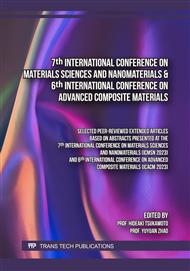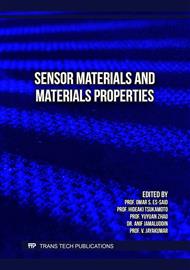[1]
A. J. Doolin et al., "Sustainable solvent selection for the manufacture of methylammonium lead triiodide (MAPbI 3) perovskite solar cells," vol. 23, no. 6, pp.2471-2486, 2021.
DOI: 10.1039/d1gc00079a
Google Scholar
[2]
P. Čulík et al., "Design and Cost Analysis of 100 MW Perovskite Solar Panel Manufacturing Process in Different Locations," vol. 7, no. 9, pp.3039-3044, 2022.
DOI: 10.1021/acsenergylett.2c01728
Google Scholar
[3]
T. Wu et al., "The main progress of perovskite solar cells in 2020–2021," vol. 13, pp.1-18, 2021.
Google Scholar
[4]
A. Kojima, K. Teshima, Y. Shirai, and T. J. J. o. t. a. c. s. Miyasaka, "Organometal halide perovskites as visible-light sensitizers for photovoltaic cells," vol. 131, no. 17, pp.6050-6051, 2009.
DOI: 10.1021/ja809598r
Google Scholar
[5]
N. J. Jeon, J. H. Noh, Y. C. Kim, W. S. Yang, S. Ryu, and S. I. J. N. m. Seok, "Solvent engineering for high-performance inorganic–organic hybrid perovskite solar cells," vol. 13, no. 9, pp.897-903, 2014.
DOI: 10.1038/nmat4014
Google Scholar
[6]
M. A. Green, A. Ho-Baillie, and H. J. J. N. p. Snaith, "The emergence of perovskite solar cells," vol. 8, no. 7, pp.506-514, 2014.
DOI: 10.1038/nphoton.2014.134
Google Scholar
[7]
K. T. Cho et al., "Highly efficient perovskite solar cells with a compositionally engineered perovskite/hole transporting material interface," vol. 10, no. 2, pp.621-627, 2017.
DOI: 10.1039/c6ee03182j
Google Scholar
[8]
L. A. Frolova et al., "Efficient and stable MAPbI3-based perovskite solar cells using polyvinylcarbazole passivation," vol. 11, no. 16, pp.6772-6778, 2020.
Google Scholar
[9]
M. Moret, A. Tiberj, W. Desrat, O. J. S. Briot, and Microstructures, "Properties of MAPbI3 perovskite layers grown with HCl additions," vol. 120, pp.136-140, 2018.
DOI: 10.1016/j.spmi.2018.05.033
Google Scholar
[10]
J. Cao, F. J. E. Yan, and E. Science, "Recent progress in tin-based perovskite solar cells," vol. 14, no. 3, pp.1286-1325, 2021.
DOI: 10.1039/d0ee04007j
Google Scholar
[11]
J. George, A. P. Joseph, and M. J. I. J. o. E. R. Balachandran, "Perovskites: Emergence of highly efficient third‐generation solar cells," vol. 46, no. 15, pp.21856-21883, 2022.
DOI: 10.1002/er.8707
Google Scholar
[12]
N. Zibouche, M. S. J. A. a. m. Islam, and interfaces, "Structure–Electronic Property Relationships of 2D Ruddlesden–Popper Tin-and Lead-based Iodide Perovskites," vol. 12, no. 13, pp.15328-15337, 2020.
DOI: 10.1021/acsami.0c03061
Google Scholar
[13]
B. Chen et al., "Anisotropic Optoelectronic Properties of MAPbI 3 on (100),(112) and (001) Facets," vol. 50, pp.6881-6887, 2021.
Google Scholar
[14]
N. Giesbrecht et al., "Single-crystal-like optoelectronic-properties of MAPbI 3 perovskite polycrystalline thin films," vol. 6, no. 11, pp.4822-4828, 2018.
DOI: 10.1039/c7ta11190h
Google Scholar
[15]
K. Fradi, A. Bouich, B. Slimi, and R. J. O. Chtourou, "Towards improving the optoelectronics properties of MAPbI3 (1− x) B3x/ZnO heterojunction by bromine doping," vol. 249, p.168283, 2022.
DOI: 10.1016/j.ijleo.2021.168283
Google Scholar
[16]
G. Gordillo, O. G. Torres, M. C. Abella, J. C. Pena, O. J. J. o. M. R. Virguez, and Technology, "Improving the stability of MAPbI3 films by using a new synthesis route," vol. 9, no. 6, pp.13759-13769, 2020.
DOI: 10.1016/j.jmrt.2020.09.095
Google Scholar
[17]
L. McGovern, M. H. Futscher, L. A. Muscarella, and B. J. T. j. o. p. c. l. Ehrler, "Understanding the stability of MAPbBr3 versus MAPbI3: suppression of methylammonium migration and reduction of halide migration," vol. 11, no. 17, pp.7127-7132, 2020.
DOI: 10.1021/acs.jpclett.0c01822
Google Scholar
[18]
M. Caputo et al., "Electronic structure of MAPbI3 and MAPbCl3: importance of band alignment," Scientific reports, vol. 9, no. 1, pp.1-11, 2019.
Google Scholar
[19]
J. C. Garcia et al., "Band structure derived properties of HfO2 from first principles calculations," in AIP Conference Proceedings, 2005, vol. 772, no. 1, pp.189-191: American Institute of Physics.
DOI: 10.1063/1.1994057
Google Scholar
[20]
F. F. Targhi, Y. S. Jalili, and F. J. R. i. p. Kanjouri, "MAPbI3 and FAPbI3 perovskites as solar cells: Case study on structural, electrical and optical properties," vol. 10, pp.616-627, 2018.
DOI: 10.1016/j.rinp.2018.07.007
Google Scholar
[21]
A. Bonadio et al., "Entropy-driven stabilization of the cubic phase of MaPbI 3 at room temperature," Journal of Materials Chemistry A, vol. 9, no. 2, pp.1089-1099, 2021.
Google Scholar
[22]
Y. H. Soo, S. A. Ng, Y. H. Wong, and C. Y. J. J. o. M. S. M. i. E. Ng, "Thermal stability enhancement of perovskite MAPbI3 film at high temperature (150° C) by PMMA encapsulation," vol. 32, no. 11, pp.14885-14900, 2021.
DOI: 10.1007/s10854-021-06041-y
Google Scholar
[23]
P. Giannozzi et al., "QUANTUM ESPRESSO: a modular and open-source software project for quantum simulations of materials," vol. 21, no. 39, p.395502, 2009.
Google Scholar
[24]
A. Marini, C. Hogan, M. Grüning, and D. J. C. P. C. Varsano, "Yambo: an ab initio tool for excited state calculations," vol. 180, no. 8, pp.1392-1403, 2009.
DOI: 10.1016/j.cpc.2009.02.003
Google Scholar
[25]
D. Kammerlander, S. Botti, M. A. Marques, A. Marini, and C. J. P. R. B. Attaccalite, "Speeding up the solution of the Bethe-Salpeter equation by a double-grid method and Wannier interpolation," vol. 86, no. 12, p.125203, 2012.
DOI: 10.1103/physrevb.86.125203
Google Scholar
[26]
F. B. Aron Walsh, Jarvist Moore Frost,, "''WMD-group/hybrid-perovskites: Collection 1 '' DOI 10.5281/zenodo.2641357, https://github.com/WMD-group/hybrid-perovskites." last access in 26 june 2023.
Google Scholar
[27]
S. Liu et al., "Role of organic cation orientation in formamidine based perovskite materials," vol. 11, no. 1, pp.1-10, 2021.
Google Scholar
[28]
R. Syah et al., "The effect of structural phase transitions on electronic and optical properties of cspbi3 pure inorganic perovskites," vol. 11, no. 10, p.1173, 2021.
DOI: 10.3390/coatings11101173
Google Scholar
[29]
W. Setyawan and S. J. C. m. s. Curtarolo, "High-throughput electronic band structure calculations: Challenges and tools," vol. 49, no. 2, pp.299-312, 2010.
DOI: 10.1016/j.commatsci.2010.05.010
Google Scholar
[30]
J. Kangsabanik, M. K. Svendsen, A. Taghizadeh, A. Crovetto, and K. S. J. J. o. t. A. C. S. Thygesen, "Indirect band gap semiconductors for thin-film photovoltaics: High-throughput calculation of phonon-assisted absorption," vol. 144, no. 43, pp.19872-19883, 2022.
DOI: 10.1021/jacs.2c07567
Google Scholar
[31]
M. S. J. L. N. Dresselhaus, "Solid state physics part ii optical properties of solids," vol. 17, pp.15-16, 2001.
Google Scholar



